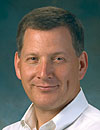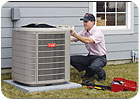
Steve Yurek, president of ARI
“Our industry is strong,” said Steve Yurek, president of the Air-Conditioning and Refrigeration Institute (ARI). “The residential market is stabilizing back to its normal growth rate, while the commercial market is hot and continuing to grow.”
Yurek continued to explain the slowing conditions as a matter of comparisons. “Compared to 2005, the unitary numbers slipped in 2006, but 2005 was an abnormal year,” he said. “If you compare 2006 to 2004, you’ll find that the numbers are better aligned. We believe the industry will return to more normal shipment numbers in 2007.”
Manufacturers attributed the decline in industry-wide unitary shipment numbers to several factors. “Both the drop in new housing starts, and the inventory build-up of 10 and 12 SEER products that occurred prior to Jan. 26, 2006, added to the fading of shipment numbers,” said Al Knight, product manager, split systems, Goodman Manufacturing. “Many of these 10 and 12 SEER units were shipped to distributors in 2005 and sold to in-stalling contractors in 2006.”
LOOKING BACK
Falling unitary numbers weren’t the only obstacles that manufacturers tackled. Component availability, increased material costs, and rising efficiency demands caused ripples in the manufacturing pool.“Many manufacturers faced challenges in meeting demand for 13 and higher SEER systems when certain components, such as TXVs, became essential,” noted Andy Armstrong, director of marketing, North America, Johnson Controls, Unitary Products. “This created production challenges.”
According to Rheem, TXVs have a profound effect on being able to achieve coil and overall system efficiency minimums, causing them to become a staple of the industry. “When manufacturers began relying on TXVs for the majority of their 13 SEER systems, component manufacturers’ inability to provide TXVs in a timely manner created shortages,” explained Knight.
Another destabilizing factor last year was the increased and unpredictable material costs and their limited availability. Raw material availability remained an issue as the aftermath of Hurricanes Katrina and Rita continued to strain supplies. The rising prices of raw materials, including steel, copper, aluminum, and nickel, also made it difficult for manufacturers to keep costs under control.
“Because the rise in raw material costs followed so closely on the heels of the 13 SEER changeover,” explained Yurek, “manufacturers had less ability to pass along cost increases to consumers.”
However, “The greatest challenge for manufacturers in today’s 13 SEER world is ensuring maximum product efficiency,” said Mark King, outdoor product manager, Rheem Residential. “Electricity saw an average increase of 8-10 percent, while natural gas, heating oil, propane, and kerosene increased 25-30 percent.” According to King, many homeowners sought cost relief through alternatives like the heat pump.
“The shifting ratio of air conditioners to heat pumps was a challenge,” said Knight. “And, when the Department of Energy (DOE) mandated the increased efficiency, adjusting to the new sales ratios at the various SEER levels became difficult.”
“It is also interesting to note that following the transition to the mandated 13 SEER standard, the market did not necessarily commoditize around 13 SEER products,” said Doug Young, president and COO, residential heating and cooling, Lennox International Inc. “There is also an emerging market for products rated 14 SEER and higher.”

Andy Armstrong, director of marketing, North America, Johnson Controls, Unitary Products
CHANGING CHALLENGES
Having conquered so many challenges already, manufacturers are looking at the new opportunities and obstacles that lie ahead. “This industry is and has been on the leading edge of manufacturing,” said Yurek. “We foresee a good year with broader product offerings in the 13 SEER and beyond range.”Armstrong expects that there will be significant innovation in new and upgraded HVAC systems from leading manufacturers this year.
“Drivers for this include energy efficiency and cost, environmental concerns, indoor comfort and health, consumer-oriented design, aesthetic qualities, and smart controls.”
When it comes to energy efficiency and cost, however, Robert Flynn, senior vice president of corporate development, Taco Inc., sees challenges on the horizon. “There are currently far too few innovative products addressing the industry’s growing energy and water conservation issue,” he warned.
Knight was also concerned about future energy-efficiency challenges. According to him, the incentive programs from federal, state, and local government agencies and utility companies lack a consistency that would help manufacturers design their products.
“The Consortium for Energy Efficiency specifies its top-tier efficiency for heat pumps to be 15 SEER, 12.5 EER, and 8.5 HSPF, while the federal government’s requirement for a $300 tax credit is 15 SEER, 13 EER, and 9 HSPF,” he reported. “And, while the national minimum SEER is 13, we still face myriad state and local regulations that mandate a minimum SEER higher than 13 in particular applications.”
In addition to managing product efficiencies, manufacturers are focusing on ensuring a smooth transition to the upcoming 2010 mandatory R-410A refrigerant changeover. The market will require more R-410A products, more heat pumps, and more 14 and higher SEER products each year, according to Knight.
“Many manufacturers have been actively phasing in a full menu of R-410A refrigerant equipped products well in ad-vance of 2010,” said Rheem.
According to Bryant, however, sustainable design is more than moving to “green” refrigerants. “Green building practices are also gaining momentum as energy costs and the public’s environmental awareness increases,” said Halsey Cook, president, Bryant Residential and Light Commercial Systems. “According to LEED and the USGBC, buildings consume about 1/3 of the total energy used in the United States, and 2/3 of the electricity. Therefore, HVAC system efficiency improvements will have a big effect on energy usage.”
Another challenge manufacturers are watching is the ad-vancement of technology and its multiple implications.
“A significant challenge is reaching higher efficiency levels without dramatic increases in cost and size of products, both outdoor and indoor,” said Armstrong.
“We are constantly looking for technology developments in compressors and coils, and how coils and units are fabricated and assembled,” noted Knight. “The refrigerants and metals we use today may not be the refrigerants and metals we are using 10 years from now.”
Manufacturers are keeping a close eye on the steady growth of foreign markets.
“Our future concerns, though not new, include excess production capacity among U.S. manufacturers, increased competition in North America from offshore manufacturers, and increased competition in the channel from the large retail chains that offer HVAC system sales, installation, and service,” explained Armstrong.
“The flow of products from low-wage countries will continue,” said Knight, “and we must find ways to stay competitive if we are to continue building our products in the United States.”

According to Bryant, sustainable design is more than moving to “green” refrigerants. Green building practices are gaining momentum as research reveals that HVAC system efficiency improvements will have an effect on energy usage.
CRYSTAL BALL GAZING
HVAC manufacturing market predictions and forecasts can be difficult. “We anticipate continued movement toward more planned replacement in our commercial national accounts,” said Harry Bizios, president and COO, commercial heating and cooling, Lennox International Inc. “The commercial HVAC market in general will place an increasing focus on energy efficiency, indoor air quality improvement, and more environmentally friendly products.”According to Cook, the newest systems coming out will self-configure and have the ability to be monitored from anywhere. “They will even have the capability to call for help in the event of a system malfunction,” said the company. “These systems will extend the efficiency horizon and provide improved homeowner comfort.”
With energy efficiency, domestic market, and global changes occurring daily, HVAC manufacturers will have to take up the gauntlet once again in 2007.
Publication date:03/26/2007


Report Abusive Comment